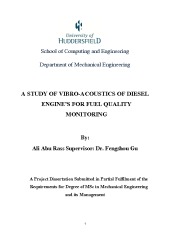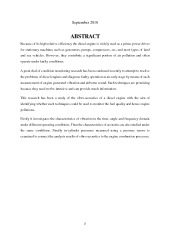Diagnosis Of Diesel Engines



Diagnosis of Diesel engines.
The greater fuel economy longer periods between services that the diesel engine offers means it has long been a favourite with the transport industry for use in heavy commercial vehicles. About sixty years ago there was a substantial increase in the number of small, high speed four stroke diesel engines used in taxis, delivery vans, light trucks and agricultural tractors. Here the economy of the diesel engine was the major attraction, overcoming the disadvantages of higher noise levels, increased engine weight and lower specific power output [8]. The great majority of new merchant ships enter service powered by diesel engines, and many existing ships have had their original power units replaced by diesel engines to improve economy and give an extended working life [29].
The greatest constraints on the high speed diesel engine occur when it is used in the domestic car, in particular noise, engine weight and size are of increasing importance. The progressive reduction in the size of cars in the search for greater operating efficiency increases the importance of these factors [8]. [3].
The diesel engine comes with either a two-stroke or four strokes. Troubleshooting for diesel engines are considered relatively easy, and each of the above two designs will show faults which are restricted to that engine.
Considering first the operation of the two stroke engine, Asmus (1995) investigated available two stroke engines that do not use valves but operate with ports only. One such design uses intake ports situated near the centre of the cylinder line with conventional push-type exhaust valves at the top of the cylinder, see Figure 1-1 which shows a Vee-configured engine layout. The only difference between the inline two stroke and Vee diesel engines is in the basic cylinder arrangement.
Without a spark plug diesel engines require a much greater compression ratio because the heat generated by compressing the air/fuel mixture in the cylinder is what causes the diesel fuel to ignite and initiate combustion.
Figure 1 -1: shows how the two stroke diesel engine working [3]
However, today, the majority of high speed diesel engines manufactured is of the four-stroke type. Figure 1-2 can be used to describe the four piston strokes in a four-stroke diesel engine. These are [11]
The intake stroke: at the start of the intake stroke the piston is at the very top of the cylinder – known as top dead centre (TDC). The piston begins to move downwards reducing the pressure in the cylinder, and as it does so the intake valve opens. Air is pushed into the cylinder by atmospheric pressure. The intake valve closes when the piston reaches bottom dead centre (BDC).
The power stroke: As the piston nears TDC fuel is injected into the combustion chamber and ignites spontaneously as it meets the hot air. This begins the power stroke. The burning gases experience a rapid rise in temperature and exert a substantial downward force on the piston, pushing it downward. It is this force which drives the crankshaft. Because the flame speed of diesel is much slower than that of gasoline, diesel fuel will continue to bum throughout most the power stroke while gasoline will tend to be consumed early in the power stroke.
- Automotive Graduate works
- Microsoft Word 7700 KB
- 2017 m.
- English
- 64 pages (10703 words)
- University
- Gabrielius












